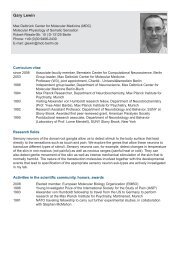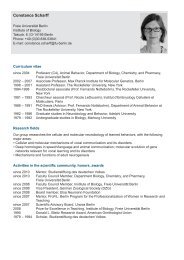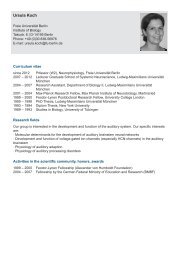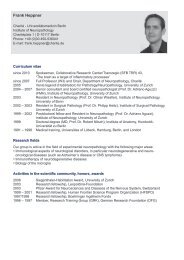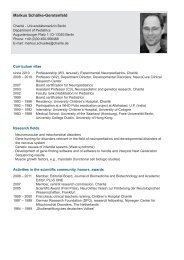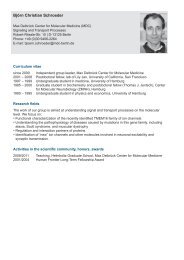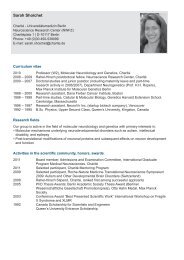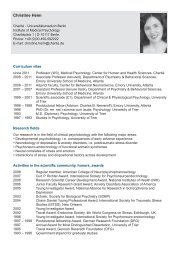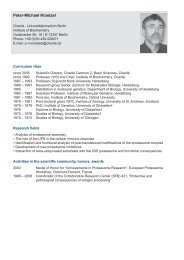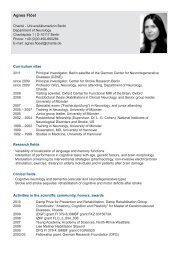You also want an ePaper? Increase the reach of your titles
YUMPU automatically turns print PDFs into web optimized ePapers that Google loves.
<strong>Stephan</strong> <strong>Sigrist</strong><br />
Freie Universität Berlin<br />
Institute of Biology<br />
Takustr. 6 | D-14195 Berlin<br />
Phone: +49 (0)30 838-56940<br />
E-mail: stephan.sigrist@fu-berlin.de<br />
Curriculum vitae<br />
since 2009 Member, Board of Directors, <strong>NeuroCure</strong> Cluster of Excellence<br />
since 2008 Professor (W3), Genetics, Institute for Biology, Freie Universität Berlin and <strong>NeuroCure</strong><br />
Cluster of Excellence, Charité - Universitätsmedizin Berlin<br />
2006 – 2008 Professor (W2) for Experimental Biomedicine and Bio-Imaging, Rudolf Virchow Center<br />
of Excellence, Universität Würzburg<br />
2002 – 2005 Spokesman, Nachwuchsgruppen der Max Planck Gesellschaft<br />
2001 – 2006 Independent junior research group ”Neuroplasticity”, Max Planck Society at the<br />
European Neuroscience Institute, Göttingen<br />
1997 – 2000 Postdoc with Christoph Schuster, Max Planck Institute, Tübingen<br />
1993 – 1997 Doctoral thesis (Dr. rer. nat., Advisor: Prof. Dr. Christian F. Lehner), Friedrich Miescher<br />
Laboratory of the Max Planck Institute, Tübingen<br />
Research fields<br />
Our group is active in the field of cellular and molecular neurobiology with the following major areas:<br />
n Cellular and molecular mechanisms of synapse formation and plasticity<br />
n Molecular mechanisms of synaptic transmission<br />
n Molecular organization of synapses in physiological and pathophysiological states<br />
n “Synaptopathy” in neurological-psychiatric and neurodevelopmental diseases, particularly autism<br />
Activities in the scientific community, honors, awards<br />
2005 Best “habilitation” award, Faculty of Medicine, University of Göttingen<br />
2000 Long-Term Research Fellowship, European Molecular Biology Organization (EMBO)<br />
and HFSP Long-Term Research Fellowship
Selected publications<br />
Owald D, Khorramshahi O, Gupta VK, Banovic D, Depner H, Fouquet W, Wichmann C, Mertel S,<br />
Eimer S, Reynolds E, Holt M, Aberle H, <strong>Sigrist</strong> SJ. Cooperation of Syd-1 with Neurexin<br />
synchronizes pre- with postsynaptic assembly. NatNeurosci. 2012; 15, 1219-26.<br />
Liu KS, Siebert M, Mertel S, Knoche E, Wegener S, Wichmann C, Matkovic T, Muhammad K,<br />
Depner H, Mettke C, Buckers J, Hell SW, Muller M, Davis GW, Schmitz D, <strong>Sigrist</strong> SJ. RIM-binding<br />
protein, a central part of the active zone, is essential for neurotransmitter release. Science. 2011;<br />
334, 1565-1569<br />
Owald D, Fouquet W, Schmidt M, Wichmann C, Mertel S, Depner H, Christiansen F, Zube C,<br />
Quentin C, Korner J, Urlaub H, Mechtler K, <strong>Sigrist</strong> SJ. A Syd-1 homologue regulates pre- and<br />
postsynaptic maturation in Drosophila. J Cell Biol 2010; 188, 565-579<br />
Banovic D, Khorramshahi O, Owald D, Wichmann C, Riedt T, Fouquet W, Tian R, <strong>Sigrist</strong> SJ*,<br />
Aberle H*. Drosophila neuroligin 1 promotes growth and postsynaptic differentiation at<br />
glutamatergic neuromuscular junctions. Neuron. 2010;66, 724-738| *correspondance shared<br />
Fouquet W, Owald D, Wichmann C, Mertel S, Depner H, Dyba M, Hallermann S, Kittel RJ, Eimer<br />
S, <strong>Sigrist</strong> SJ. Maturation of active zone assembly by Drosophila Bruchpilot. J Cell Biol 2009; 186,<br />
129-145<br />
Schmid A, Hallermann S, Kittel RJ, Khorramshahi O, Frolich AM, Quentin C, Rasse TM, Mertel S,<br />
Heckmann M, <strong>Sigrist</strong> SJ. Activity-dependent site-specific changes of glutamate receptor<br />
composition in vivo. Nat Neurosci. 2008; 11, 659-666<br />
Wagh DA, Rasse TM, Asan E, Hofbauer A, Schwenkert I, Durrbeck H, Buchner S, Dabauvalle MC,<br />
Schmidt M, Qin G, Wichmann C, Kittel R, <strong>Sigrist</strong> SJ, Buchner, E. Bruchpilot, a protein with<br />
homology to ELKS/CAST, is required for structural integrity and function of synaptic active zones in<br />
Drosophila. Neuron. 2006; 49, 833-844<br />
Kittel RJ, Wichmann C, Rasse TM, Fouquet W, Schmidt M, Schmid A, Wagh DA, Pawlu C, Kellner<br />
RR, Willig KI, Hell SW, Buchner E, Heckmann M, <strong>Sigrist</strong> SJ. Bruchpilot promotes active zone<br />
assembly, Ca2+ channel clustering, and vesicle release. Science. 2006; 312, 1051-1054<br />
Rasse T M, Fouquet W, Schmid A, Kittel RJ, Mertel S, <strong>Sigrist</strong> C B, Schmidt M, Guzman A., Merino<br />
C, Qin G, Quentin C, Madeo FF, Heckmann M, <strong>Sigrist</strong> SJ. Glutamate receptor dynamics organizing<br />
synapse formation in vivo. Nat Neurosci. 2005; 8, 898-905<br />
<strong>Sigrist</strong> SJ, Thiel PR, Reiff DF, Lachance PE, Lasko P, Schuster CM. Postsynaptic translation<br />
affects the efficacy and morphology of neuromuscular junctions. Nature. 2000; 405, 1062-5.




